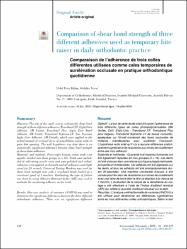| dc.contributor.author | Kılınç, Delal Dara | |
| dc.contributor.author | Sayar, Gülşilay | |
| dc.date.accessioned | 2021-01-26T11:44:35Z | |
| dc.date.available | 2021-01-26T11:44:35Z | |
| dc.date.issued | 2018 | en_US |
| dc.identifier.citation | Kılınç, D. D. ve Sayar, G. (2018). Comparison of shear bond strength of threedifferent adhesives used as temporary biteraiser in daily orthodontic practice. International Orthodontic, 16, 440-449. http://dx.doi.org/10.1016/j.ortho.2018.06.011 | en_US |
| dc.identifier.issn | 1761-7227 | |
| dc.identifier.issn | 1879-680X | |
| dc.identifier.uri | http://dx.doi.org/10.1016/j.ortho.2018.06.011 | |
| dc.identifier.uri | https://hdl.handle.net/20.500.12511/6402 | |
| dc.description.abstract | Objective: The aim of this study was to evaluate the shear bondstrength of three different adhesives (Transbond XT, Light CureAdhesive, 3M Unitek; Transbond Plus, Light Cure BandAdhesive, 3M Unitek; Transbond Supreme LV, Low ViscosityLight Cure Adhesive, 3M Unitek), which were applied to theetched enamel of occlusal faces of mandibular molar teeth togain bite opening. The null hypothesis was that there is nostatistically significant difference between shear bond strengthof these three adhesives.Materials and methods: Forty-eight human molar teeth wereequally divided into three groups (n = 16). Teeth were embed-ded in self-curing acrylic resin and were polished and etched.Adhesives were applied on the teeth and all adhesives were lightcured for 20 seconds. Universal Testing Machine was used forshear bond strength tests with a crosshead blade loaded at acrosshead speed of 1 mm/min. Evaluating the type of failurewas done by using Adhesive Remnant Index (ARI) was used toevaluate the remaining adhesive on the tooth.Results: One-way analysis of variance (ANOVA) was used todetermine the significant differences between the three differentorthodontic adhesives. There was no significant difference (P = 0.774) between the groups according to ANOVA test.According to Kruskal–Wallis test there was no statisticallysignificant differences in ARI scores among groups (P<0.01).Conclusion: The null hypothesis was accepted. There was nostatistically significant difference among their bond strengthvalues. All of three materials can be used as temporary biteopeners. | en_US |
| dc.description.abstract | Objectif : Le but de cette etude etait d’ evaluer l’adh erence detrois diff erents types de colles photopolym erisables (3MUnitek, Calif, Etats-Unis : Transbond XT, Transbond Pluspour bagues, Transbond Supreme LV de basse viscosit e),appliqu ees sur l’ email mordanc e des faces occlusales demolaires mandibulaires pour sur elever l’occlusion.L’hypoth ese nulle etait qu’il n’y a aucune diff erence statisti-quement significative de r esistance aux forces de cisaillemententre ces trois adh esifs.Mat eriels et m ethodes : Quarante-huit molaires humaines ont et e egalement r eparties en trois groupes (n = 16). Les dentsont et e incluses dans une r esine acrylique autopolym erisable,puis polies et mordanc ees. Les adh esifs ont et e appliqu es surles dents, et tous les adh esifs ont et e photopolym eris es dur-ant 20 secondes. Une machine universelle d’essais a et eutilis ee pour les tests de r esistance aux forces de cisaillementavec une lame de force dont la t^ete sed eplace a`la vitesse de1 mm/mn. L’ evaluation de la nature de la d efaillance du col-lage a et e effectu ee a`l’aide de l’Indice d’adh esif r esiduel(IAR) qui refl ete la quantit e d’adh esif r esiduel sur la dent.R esultats : L’analyse unidirectionnelle de variance (ANOVA) a et e utilis ee pour d eterminer les diff erences significativesentre les trois diff erentes colles orthodontiques. Selon le test ANOVA, il n’existe aucune diff erence significative (p = 0,774)entre les groupes. Selon le test de Kruskal–Wallis, il n’y aaucune diff erence statistiquement significative pour lesscores IAR entre les groupes (p<0,01).Conclusion : L’hypoth ese nulle a et e valid ee. Nous n’avonstrouv e aucune diff erence statistiquement significatived’adh erence entre les diff erentes colles. Les trois mat eriauxpeuvent donc^etre utilis es comme cales de sur el evationocclusale temporaires. | en_US |
| dc.language.iso | eng | en_US |
| dc.publisher | Elsevier Masson | en_US |
| dc.rights | info:eu-repo/semantics/embargoedAccess | en_US |
| dc.subject | Bite Raiser | en_US |
| dc.subject | Orthodontic Adhesives | en_US |
| dc.subject | Bond Strength | en_US |
| dc.subject | Bonding | en_US |
| dc.subject | Orthodontics | en_US |
| dc.subject | Cale de Sur el Evation Occlusale | en_US |
| dc.subject | Adh Esifs Orthodontiques | en_US |
| dc.subject | Adh Erence | en_US |
| dc.subject | Collage | en_US |
| dc.subject | Orthodontie | en_US |
| dc.title | Comparison of shear bond strength of threedifferent adhesives used as temporary biteraiser in daily orthodontic practice | en_US |
| dc.title.alternative | Comparaison de l’adh erence de trois collesdiff erentes utilis ees comme cales temporaires desur el evation occlusale en pratique orthodontiquequotidienne | en_US |
| dc.type | article | en_US |
| dc.relation.ispartof | International Orthodontic | en_US |
| dc.department | İstanbul Medipol Üniversitesi, Diş Hekimliği Fakültesi, Ortodonti Ana Bilim Dalı | en_US |
| dc.authorid | 0000-0001-9009-6218 | en_US |
| dc.authorid | 0000-0003-3294-2644 | en_US |
| dc.identifier.volume | 16 | en_US |
| dc.identifier.startpage | 440 | en_US |
| dc.identifier.endpage | 449 | en_US |
| dc.relation.publicationcategory | Makale - Uluslararası Hakemli Dergi - Kurum Öğretim Elemanı | en_US |
| dc.identifier.doi | 10.1016/j.ortho.2018.06.011 | en_US |


















